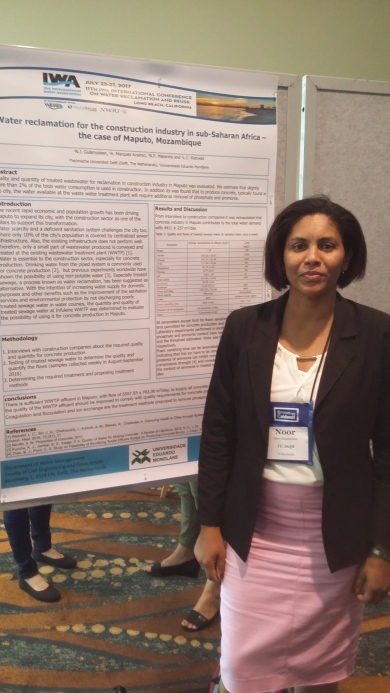By Noor
It was 16:30 on the 21st of July 2017 that I arrived at Long Beach airport after a long trip from Maputo, on a sunny day with nice and warm weather.
The next day, was reserved for a tour to San Diego where we visited two water purification pilot plants, the Pure Water San Diego – Demonstration Pure Water Facility and the Padre Dam’s Advanced Water Purification Program. The Pure Water San Diego facility uses ozonation, biological activated carbon, membrane filtration, reverse osmosis and advanced oxidation with ultraviolet light to produce drinking water. This program will provide 1/3 of San Diego’s water supply locally by 2035. Padre Dam imports 100% of its drinking water supply from the Sacramento Bay Delta and the Colorado River – hundreds of miles away. A water recycling opportunity was identified by the managers of Padre Dam that will diversify East San Diego County’s water supply and reduce its dependency on imported water. The East County Advanced Water Purification pilot at Padre Dam use a four-step process of free chlorine disinfection, membrane filtration, reverse osmosis and advanced oxidation to purify recycled water. This water reuse program would diversify East County’s water supply and reduce dependence on imported water. The full-scale program will produce approximately 25-30% of East County’s current drinking water demands.
On the 23rd the conference started with a very interesting workshop on successful strategies for sustainable industrial water reuse. The panellists from different industries, water boards and academy described the motivations for companies to implement water reuse strategies and discussed the technologies used to reuse and recycle water in industrial settings. These strategies were further illustrated with case studies that explored the implementation of industrial water reuse from both public and private perspectives. The welcome reception was toasted with beer tasting of Padre Dam Pilsener produced with water from advanced water purification program demonstration facility in Santee.
The following three days comprised key note sessions, oral and poster presentations. With my participation I presented a poster entitled “Water reclamation for the construction industry in sub-Saharan Africa – the case of Maputo, Mozambique” and you can grab a copy here. This work was aimed at determining the quantity and quality of treated sewage water at Infulene WWTP to evaluate the possibility of using it for concrete production in Maputo.

Noor at IWA’s conference next to her poster.
This was also an opportunity for networking that resulted in the idea of creation of an advisory group with a mission of leverage and develop relationships with water professionals to augment Water Reuse members’ knowledge with additional information about sustainable water practices, policies and technologies from around the world, and to share expertise with others who might benefit.
After the conference, on the 27th we had another tour to Los Angeles area, were we visited the Terminal Island Water Reclamation Plant, the Environmental Learning Center at Hyperion Treatment Plant and the West Basin Municipal Water District’s Edward C. Little Water Recycling Facility. The Terminal Island Water Reclamation Plants’ Advanced Water Purification Facility (AWPF) has produced highly purified recycled water using MF and RO systems since 2002 for injection into the Dominguez Gap Barrier (DGB) to protect groundwater reservoirs from seawater intrusion. The capacity of the AWPF is currently being expanded from 27 to 55 Thousands m3/Day with the new process equipment including additional MF and RO systems and an Advanced Oxidation Process (AOP). Completion of this expansion allow continued recharging of the DGB with 100% recycled water, supply of water to the Machado Lake to replenish evaporation losses and providing a replacement to potable water for various Harbor-area industrial users for non-drinking purposes. The AWPF is owned and operated by Los Angeles Sanitation and partners in the project include Los Angeles Department of Water and Power, LA County and Water Replenishment District of Southern California. We had opportunity to see the expanded MF and RO systems and the new AOP system.
West Basin’s Edward C. Little Water Recycling Facility (ECLWRF) receives secondary effluent from Hyperion Treatment Plant and provides further treatment for reuse. The ECLWRF produces five different qualities of recycled water to meet the needs of municipal, industrial and commercial customers: tertiary water for industrial and irrigation uses, nitrified water for cooling towers, softened reverse osmosis water for groundwater recharge, pure reverse osmosis water for low-pressure boiler feed, and ultra-pure reverse osmosis water for high-pressure boiler feed water at refineries.
Trends in water reclamation, particularly in US show a clear orientation to potable reuse, while in Europe most example where of industrial applications. Most interesting for my work was to learn about assessment tools for Life Cycle Analysis such as TRACI and Water Risk Monetizer that are useful for estimating the monetary value of potential increased operating costs and potential revenue losses at industrial sites. Useful was also the examples of water reclamation for industrial applications in India.
You can get a copy of Noor’s poster under publications.




















